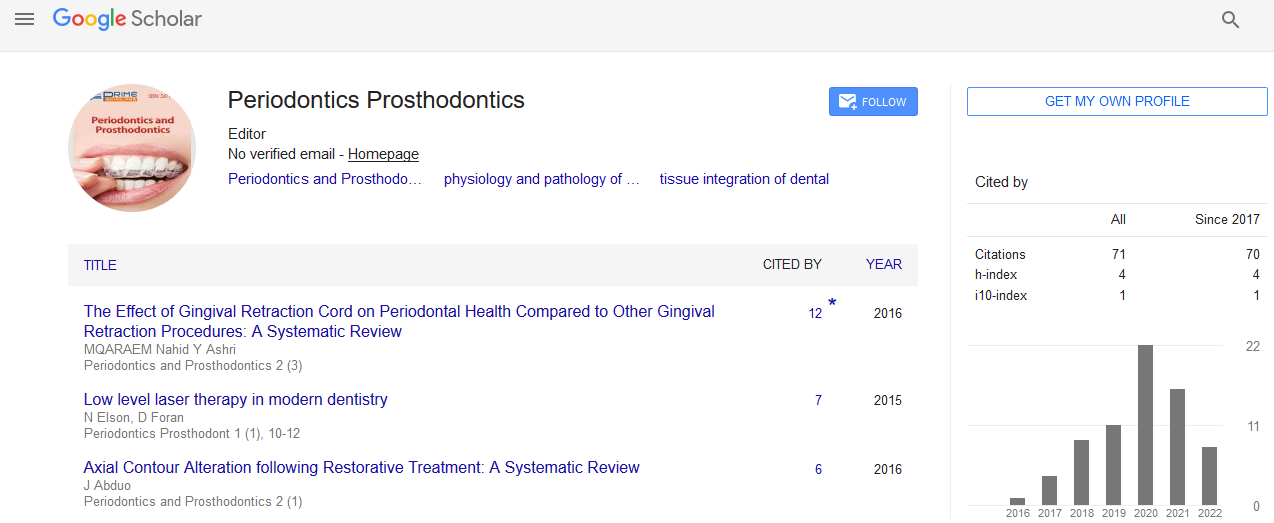Short Communication - (2024) Volume 10, Issue 4
The Role of Biomarkers in the Early Detection of Periodontal Disease
Bao Chai*
Department of Periodontology, Peking University School of Stomatology, China
*Correspondence:
Bao Chai,
Department of Periodontology, Peking University School of Stomatology,
China,
Email:
Received: 02-Dec-2024, Manuscript No. IPPDPD-25-21148;
Editor assigned: 04-Dec-2024, Pre QC No. IPPDPD-25-21148 (PQ);
Reviewed: 18-Dec-2024, QC No. IPPDPD-25-21148;
Revised: 23-Dec-2024, Manuscript No. IPPDPD-25-21148 (R);
Published:
30-Dec-2024, DOI: 10.36648/2471-3082.24.10.30
Introduction
Periodontal disease is a multifactorial inflammatory condition that affects the supporting structures of the teeth, leading to tissue destruction and potential tooth loss. Early detection and intervention are crucial in managing periodontal disease and preventing its progression. Recent advancements in molecular biology and diagnostic techniques have highlighted the po- tential role of biomarkers in the early detection of periodon- tal disease. Biomarkers, which are measurable indicators of biological processes, pathogenic processes, or pharmacologic responses, can provide valuable insights into the disease state and aid in the early diagnosis and management of periodontal conditions. This article explores the significance of biomarkers in periodontal disease and their potential to revolutionize the early detection and treatment of this common oral health issue [1,2].
Description
Biomarkers are molecules found in body fluids, such as saliva, blood, and gingival crevicular fluid, that can be used to monitor health and disease conditions. In periodontics, the identification and validation of specific biomarkers associated with periodontal disease have opened new avenues for early diagnosis and personalized treatment approaches. These biomarkers can include cytokines, enzymes, proteins, and genetic markers that reflect the underlying inflammatory and immune responses in the periodontal tissues. One of the most studied biomarkers in periodontal disease is C-reactive protein (CRP), a marker of systemic inflammation. Elevated levels of CRP in the blood have been associated with both periodontal disease and an increased risk of cardiovascular disease, underscoring the systemic implications of periodontal inflammation [3,4]. Salivary diagnostics has gained significant attention as a non-invasive method for detecting periodontal disease. Saliva, being easily accessible and containing a wide array of biomarkers, offers a convenient medium for disease monitoring. Studies have shown that salivary biomarkers such as interleukin-1β (IL-1β), matrix metalloproteinase-8 (MMP-8), and prostaglandin E2 (PGE2) are elevated in patients with periodontitis and can serve as indicators of disease activity. The use of salivary biomarkers in conjunction with traditional clinical parameters, such as probing depth and clinical attachment loss, can enhance the accuracy of periodontal disease diagnosis and allow for earlier intervention. The integration of genetic biomarkers into periodontal diagnostics is another promising area of research. Genetic variations in specific genes, such as those encoding for cytokines or receptors involved in the immune response, have been linked to an increased susceptibility to periodontal dis- ease. Genetic testing can identify individuals who are at higher risk for developing periodontitis, enabling targeted preventive measures and personalized treatment plans. Furthermore, the analysis of epigenetic modifications, such as DNA methylation patterns, has provided insights into how environmental factors and lifestyle choices influence periodontal health.
Conclusion
The use of biomarkers in the early detection and management of periodontal disease represents a significant advancement in the field of periodontics. Biomarkers offer a promising tool for identifying disease at its earliest stages, allowing for timely intervention and more effective treatment outcomes. As research in this area continues to evolve, the integration of biomarker-based diagnostics into routine clinical practice has the potential to improve patient care and reduce the burden of periodontal disease. Future studies focused on validating and standardizing the use of biomarkers in periodontal diagnostics will be essential in translating these scientific advancements into everyday dental practice.
Acknowledgement
None.
Conflict Of Interest
The author's declared that they have no conflict of interest
References
- Goodson JM (2003) Gingival crevice fluid flow. Periodontol 2000. 31(1): 43-54.
[Crossref] [PubMed]
- Nibali L, Tatarakis N, Needleman I, Tu YK, Dâ??Aiuto F, Rizzo M, et al. (2013) Association between metabolic syndrome and periodontitis: A systematic review and meta-analysis. J Clin Endocrinol Metab, 98(3): 913-920.
[Crossref] [PubMed]
- Loos BG, Papantonopoulos G, Jepsen S, Laine ML (2015) What is the contribution of genetics to Speriodontal risk?. Dent Clin North Am, 59(4): 761-780.
[Crossref] [PubMed]
- Korte DL, Kinney J (2016) Personalized medicine: An update of salivary biomarkers for periodontal diseases. Periodontol 2000, 70(1): 26-37.
[Crossref] [PubMed]
Citation: Chai B (2024) The Role of Biomarkers in the Early Detection of Periodontal Disease. Periodon Prosthodon. 10:30.
Copyright: © 2024 Chai B. This is an open-access article distributed under the terms of the Creative Commons Attribution Li- cense, which permits unrestricted use, distribution, and reproduction in any medium, provided the original author and source are credited.

